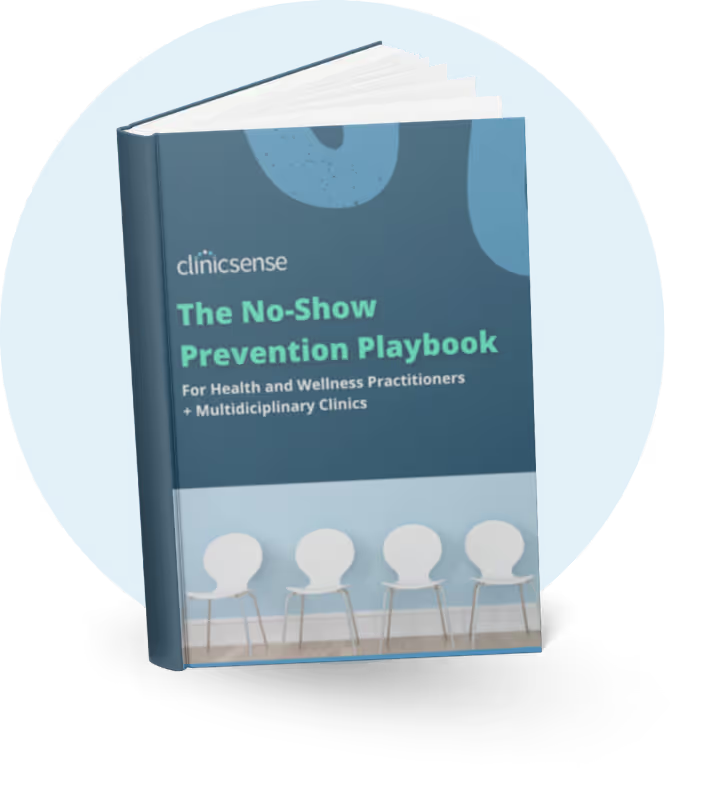Holistic Medicine Business Tips
February 27, 2025

Acupuncture has been around for thousands of years, but many people don’t realize just how much it can do. Beyond pain relief, it supports everything from better sleep to improved digestion and mental clarity. For acupuncturists, understanding and communicating the full benefits of acupuncture can help attract and retain clients while reinforcing the value of treatment.
In this article, we’ll explore some lesser-known but powerful benefits, who acupuncture is best suited for, and how to manage clients effectively to create the best possible treatment experience.
Acupuncture provides lasting health benefits, including:
Pregnancy is beautiful—but let’s be real, it comes with its fair share of discomforts. The benefits of acupuncture while pregnant include easing nausea, reducing back pain, improving sleep, and even prepping the body for labor. It’s a gentle, natural way to support both mom and baby throughout the journey.
Struggling to get a good night's sleep? Acupuncture helps regulate the nervous system, quiet a restless mind, and promote deeper, more restorative sleep. By targeting specific acupuncture points, it supports natural sleep cycles, making it easier to drift off and wake up feeling refreshed.
Stress and anxiety can take a toll on both the mind and body. The benefits of acupuncture for anxiety include calming the nervous system, reducing cortisol levels, and promoting a sense of balance. It’s a natural way to ease tension, improve mood, and help you feel more grounded in daily life.
Chronic headaches and migraines can be debilitating, but acupuncture offers a natural way to find relief. By stimulating specific acupuncture points, it helps reduce inflammation, improve circulation, and ease muscle tension. Many people experience fewer headaches over time, along with less intensity when they do occur.
Jaw tension, toothaches, and post-dental procedure pain can be tough to manage. Acupuncture helps by reducing inflammation, improving circulation, and easing nerve sensitivity. It’s a great option for TMJ discomfort, post-extraction soreness, or general dental pain, offering relief without relying solely on pain medication.
Plantar fasciitis can make every step feel like a challenge. Acupuncture helps by increasing blood flow to the affected area, reducing inflammation, and releasing tension in the foot and calf muscles. Many people find lasting relief and improved mobility, making daily movement more comfortable.
Back pain can make even simple tasks feel difficult. Acupuncture targets key acupuncture points to reduce inflammation, release muscle tension, and improve circulation. It helps support the body's natural pain-relief mechanisms, providing long-term relief without the side effects of medication. Many people experience better mobility and less stiffness over time.
Neck and shoulder tension can build up from stress, posture issues, or daily habits. Acupuncture helps loosen tight muscles, release built-up pressure, and restore natural movement. Many people notice improved flexibility and less discomfort, making it easier to get through the day without nagging stiffness.
Acupuncture supports lung function by helping to open airways, regulate the immune system, and ease symptoms of conditions like asthma, allergies, and sinus congestion. By addressing underlying imbalances, it can make breathing feel easier and more natural, offering a drug-free way to support respiratory health.
Joint pain from osteoarthritis or other conditions can make movement difficult. Acupuncture helps by promoting better circulation in the joints, reducing stiffness, and supporting the body's natural healing process. Many people experience improved flexibility and less discomfort, making daily activities easier and more enjoyable.
Tingling, numbness, and wrist pain can make everyday tasks frustrating. Acupuncture helps by reducing nerve compression, easing muscle tightness, and promoting better hand and wrist function. Many people find relief without the need for medication or surgery, making it a natural option for managing symptoms.
Tight knots and sore muscles can limit movement and cause discomfort. Acupuncture, especially when used with trigger point therapy, helps release tension in deep muscle layers, restoring flexibility and reducing pain. It’s a natural way to address persistent muscle tightness without relying on pain medication.

Yes, acupuncture offers long-term benefits, including sustained pain relief, improved mobility, and better overall well-being. Many people find that regular treatments create lasting changes by supporting the body’s natural healing processes, balancing the nervous system, and promoting better energy flow.
A meta-analysis on chronic pain found that about 90% of acupuncture’s benefits were still present 12 months after treatment. Other research suggests that acupuncture helps regulate the nervous system and enhance circulation, leading to long-term improvements in conditions like arthritis, migraines, and stress-related disorders.
Acupuncture is beneficial for anyone looking to manage pain, reduce stress, improve sleep, or support overall wellness. It’s especially helpful for those with chronic conditions, individuals seeking a holistic approach, or those who want a natural alternative to medication for symptom relief and long-term health.
Many people turn to acupuncture after conventional treatments have failed to provide lasting relief. Unlike medications that only mask symptoms, acupuncture addresses imbalances in the body, promoting natural healing. For conditions like chronic pain, migraines, or digestive issues, acupuncture offers a proven, drug-free alternative when other approaches fall short.
Many people seek acupuncture as a natural alternative to medications that come with unwanted side effects. By stimulating specific acupuncture points, it helps the body regulate pain, stress, and inflammation without the need for drugs. As a key part of holistic medicine, acupuncture supports healing by working with the body’s own systems rather than suppressing symptoms.
Acupuncture goes beyond symptom management by addressing the root causes of imbalance in the body. It supports physical, emotional, and mental well-being by improving energy flow and restoring harmony. For those who value a natural, whole-body approach, acupuncture is an essential part of a Traditional Chinese Medicine wellness plan.
Chronic pain, migraines, digestive issues, and other persistent conditions can be difficult to manage with conventional treatments alone. Acupuncture helps by regulating the nervous system, improving circulation, and supporting the body's natural healing process. Many people with long-term conditions find that regular treatments provide lasting relief and improved overall well-being.
Managing acupuncture clients effectively requires a structured intake process, detailed SOAP notes, personalized treatment plans, and clear communication. Using a scheduling system, educating patients, and following up regularly helps build trust and ensures better treatment outcomes. Streamlining these processes improves client experience and supports long-term retention.
Acupuncture practice management software can simplify these tasks by organizing client records, automating bookings, and improving communication, allowing practitioners to focus more on patient care.

A well-structured intake process sets the stage for effective treatment. Using customizable digital intake forms allows clients to fill out their information in advance, ensuring accuracy while saving time. Digital forms keep everything organized, eliminate paperwork, and make it easy for clients to reference medications and health history. Most clients prefer this convenience, and it ensures you gather only the most relevant information for your acupuncture practice.
Accurate SOAP notes are essential for tracking client progress and refining treatment plans. By documenting symptoms, acupuncture points used, and client responses, you create a clear treatment history. Using digital SOAP notes helps streamline the process, keeps records organized, and ensures you provide consistent, high-quality care tailored to each client’s needs.
No two clients are the same, and their acupuncture treatments shouldn’t be either. A well-structured acupuncture treatment plan considers individual symptoms, lifestyle factors, and long-term goals. By tailoring sessions to each person’s needs, you improve outcomes, build trust, and encourage clients to stay consistent with their care for lasting results.
Clear communication keeps clients engaged and improves their treatment experience. Using communication tools like email newsletters, feedback requests, and appointment reminders helps you stay connected and make scheduling easy. During sessions, take time to explain the benefits of acupuncture, what to expect, and any aftercare recommendations. Educating clients builds trust and encourages long-term commitment to treatment.
Helping clients understand the benefits of acupuncture keeps them engaged and encourages long-term care. Education can happen in many ways—through conversations during appointments, social media posts that highlight acupuncture’s role in wellness, and email newsletters that share self-care tips and treatment insights. Providing brochures or short videos can also reinforce key concepts. When clients understand how acupuncture supports their health, they’re more likely to stay committed to their treatment plans.
A seamless acupuncture treatment experience starts with easy scheduling. Online booking software allows clients to make appointments at their convenience while giving you control over your availability. By structuring your schedule in a way that works best for you and your staff, you prevent burnout while keeping your practice running smoothly. Automated appointment reminders reduce no-shows and keep clients engaged, making scheduling effortless for everyone.
Following up after an acupuncture treatment is a simple way to show you care while keeping clients engaged. A quick check-in allows you to gather feedback, answer questions, and even ask for a referral if they’re happy with their results. For clients who haven’t been back in a while, a wellness check-in can remind them to stay on track with their wellness plan. Consistent follow-ups build trust and encourage long-term commitment to acupuncture.
Managing an acupuncture practice is easier when you have the right tools in place. From SOAP notes to online booking and client communication, streamlining your workflow improves both client experience and treatment outcomes. If you're looking for an acupuncture practice management software, consider trying one with an acupuncture SOAP notes free trial to enhance the benefits of acupuncture for both you and your clients.


.avif)
.avif)
.avif)









For 14 days